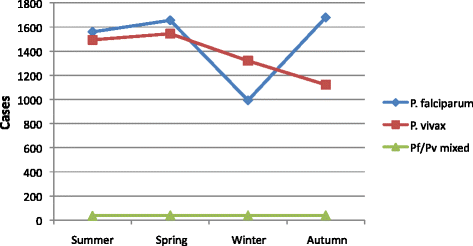Past five-year trend, current prevalence and household knowledge, attitude and practice of malaria in Abeshge, south-central Ethiopia
- PMID: 26037129
- PMCID: PMC4464226
- DOI: 10.1186/s12936-015-0749-5
Past five-year trend, current prevalence and household knowledge, attitude and practice of malaria in Abeshge, south-central Ethiopia
Abstract
Background: In Ethiopia malaria remains a leading cause of outpatient consultation despite massive control efforts. This study was aimed at analysing 5-year retrospective trend and current prevalence of malaria as well as community knowledge, attitude and practice (KAP) in Walga Health Centre (WHC) catchment area in Abeshge District, south-central Ethiopia.
Methods: A cross-sectional, household survey was conducted to determine malaria prevalence and KAP in December 2013. Further, malaria cases reported from WHC in 2008-2012 were extracted. A multi-stage, random sampling technique was used to select study participants from four kebeles. Of 800 participants, 400 were interviewed to assess their KAP about malaria and the other half were recruited for malaria microscopy.
Results: Overall, 11,523 (33.8%) slide-confirmed malaria cases were reported (no fatalities) among 34,060 outpatients diagnosed in 2008-2012. There was successively significant decline in malaria prevalence from 2009 onwards although a significant rise was noticed in 2009 compared to 2008 (p<0.0001). Male malaria suspects (17,626) were significantly higher than of females (16,434) (p=0.0127) but malaria prevalence was not significantly variable between sexes. Individuals who were ≥15 years constituted 44.9% of the patients. Although most participants (78.8%) associated mosquito bites with malaria, the remaining mentioned exposure to rain or body contact with malaria patients as causes of malaria. Mosquito nets, draining stagnant water and indoor residual spraying were the most frequently mentioned malaria preventive measures. In the parasitological survey, a single individual (0.25%) with mixed Plasmodium falciparum-Plasmodium vivax infections was found.
Conclusion: Although malaria remains a primary cause of outpatient admission in WHC, the retrospective data showed a significantly declining trend. This together with the very low prevalence in the current parasitological survey suggests the effectiveness of ongoing control interventions in the locality.
Figures
References
-
- WHO . World malaria report. Geneva, Switzerland: World Health Organization; 2013.
-
- FMoH . Health and health related indicator report. Addis Ababa, Ethiopia: Federal Ministry of Health; 2012.
-
- FMoH . National malaria guideline. 3. Addis Ababa: Federal Ministry of Health; 2012.
-
- FMoH . National strategic plan for malaria prevention, control and elimination in Ethiopia 2010–2015. Addis Ababa, Ethiopia: Federal Ministry of Health; 2010.
-
- WHO . World malaria report 2010. Geneva, Switzerland: World Health Organization; 2010.
Publication types
MeSH terms
LinkOut - more resources
Full Text Sources
Other Literature Sources
Miscellaneous


